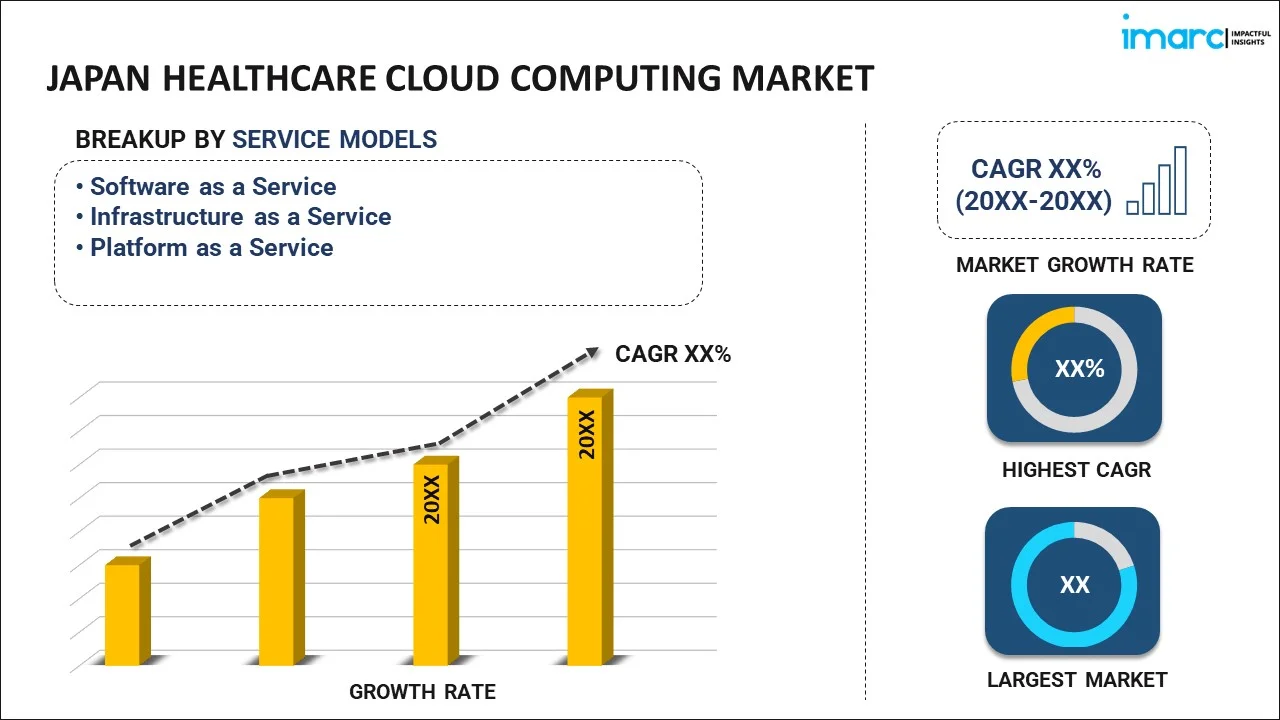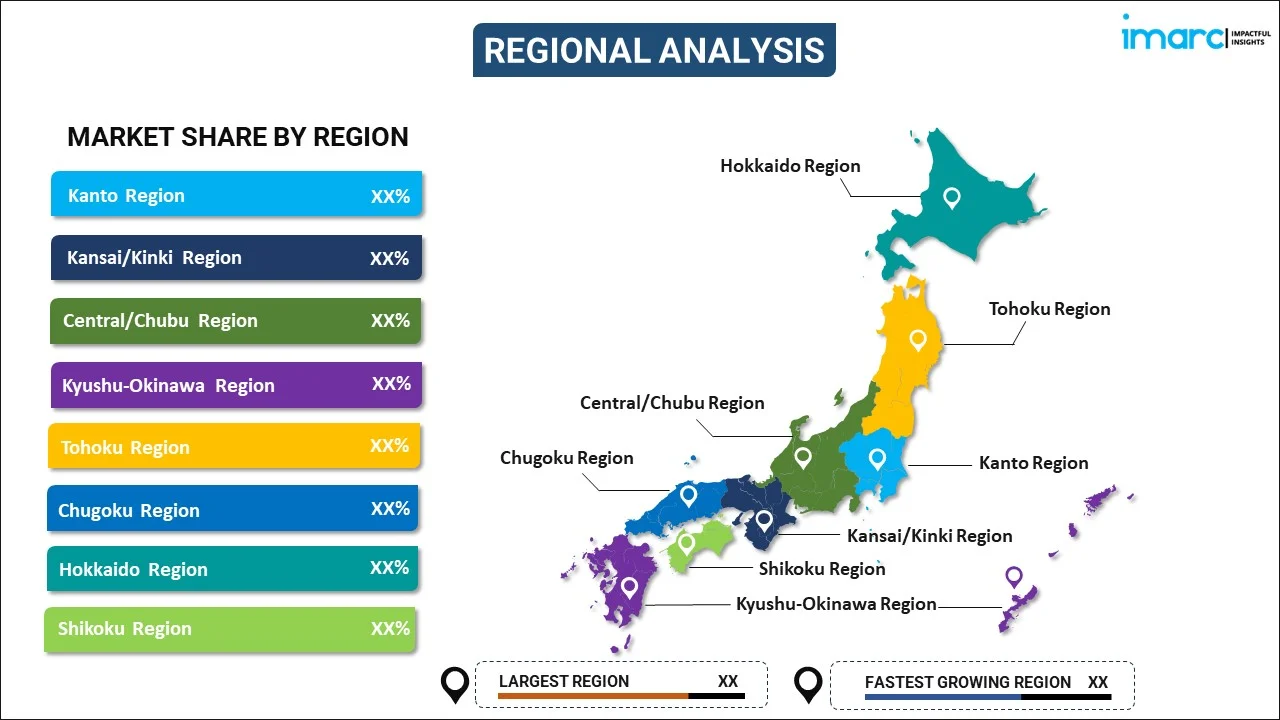
Japan Healthcare Cloud Computing Market Report by Service Model (Software as a Service, Infrastructure as a Service, Platform as a Service), Cloud Deployment Model (Private Cloud, Public Cloud, Hybrid Cloud), Application (Clinical Information System, Non-Clinical Information System), End User (Healthcare Providers, Healthcare Payers), and Region 2025-2033
Market Overview:
Japan healthcare cloud computing market size reached USD 2.3 Billion in 2024. Looking forward, IMARC Group expects the market to reach USD 6.1 Billion by 2033, exhibiting a growth rate (CAGR) of 10.62% during 2025-2033. The increasing utilization of cloud-based platforms, which enable healthcare providers to securely access patient information and provide remote healthcare services, thereby improving patient outcomes and accessibility to care, is driving the market.
|
Report Attribute
|
Key Statistics
|
|---|---|
|
Base Year
|
2024 |
|
Forecast Years
|
2025-2033
|
|
Historical Years
|
2019-2024
|
| Market Size in 2024 | USD 2.3 Billion |
| Market Forecast in 2033 | USD 6.1 Billion |
| Market Growth Rate (2025-2033) | 10.62% |
Healthcare cloud computing refers to the utilization of cloud-based services and platforms in the healthcare industry to store, manage, and analyze health-related data and information. It enables healthcare providers, such as hospitals, clinics, and medical practitioners, to access and share patient records, medical images, and other critical data securely and efficiently. Healthcare cloud computing offers scalable and cost-effective solutions, facilitating the seamless integration of various healthcare applications and services. It allows for the rapid deployment of new healthcare technologies, such as telemedicine and remote patient monitoring, enhancing the delivery of healthcare services and promoting better patient outcomes. Moreover, it ensures data security and compliance with healthcare regulations, mitigating the risks associated with data breaches and unauthorized access. By leveraging cloud computing, the healthcare industry can improve operational efficiency, promote collaboration among healthcare professionals, and ultimately enhance the overall quality of patient care.
Japan Healthcare Cloud Computing Market Trends:
The healthcare cloud computing market in Japan is burgeoning, primarily driven by several key factors. Firstly, the ever-increasing demand for cost-effective and efficient healthcare services has paved the way for the adoption of cloud computing solutions. Additionally, the rapid advancements in technology, such as the integration of artificial intelligence and big data analytics, have spurred the demand for scalable and flexible cloud-based infrastructures in the healthcare sector. Moreover, the need for secure storage and management of massive volumes of patient data, including electronic health records and medical imaging, has propelled the migration towards cloud-based platforms. Furthermore, the heightened focus on interoperability and seamless data exchange among healthcare providers has intensified the implementation of cloud solutions to facilitate streamlined collaboration and communication. Notably, the emergence of telemedicine and remote patient monitoring as integral components of modern healthcare has further catalyzed the growth of the healthcare cloud computing market in Japan, enabling remote access to critical medical information and facilitating real-time patient care delivery.
Japan Healthcare Cloud Computing Market Segmentation:
IMARC Group provides an analysis of the key trends in each segment of the market, along with forecasts at the country level for 2025-2033. Our report has categorized the market based on service model, cloud deployment model, application, and end user.
Service Model Insights:

- Software as a Service
- Infrastructure as a Service
- Platform as a Service
The report has provided a detailed breakup and analysis of the market based on the service model. This includes software as a service, infrastructure as a service, and platform as a service.
Cloud Deployment Model Insights:
- Private Cloud
- Public Cloud
- Hybrid Cloud
A detailed breakup and analysis of the market based on the cloud deployment model have also been provided in the report. This includes private cloud, public cloud, and hybrid cloud.
Application Insights:
- Clinical Information System
- Computerized Physician Order Entry
- Electronic Medical Records
- Radiology Information System
- Pharmacy Information System
- Others
- Non-Clinical Information System
- Automatic Patient Billing
- Revenue Cycle Management
- Claims Management
- Others
The report has provided a detailed breakup and analysis of the market based on the application. This includes clinical information system (computerized physician order entry, electronic medical records, radiology information system, pharmacy information system, and others) and non-clinical information system (automatic patient billing, revenue cycle management, claims management, and others).
End User Insights:
- Healthcare Providers
- Healthcare Payers
A detailed breakup and analysis of the market based on the end user have also been provided in the report. This includes healthcare providers and healthcare payers.
Regional Insights:

- Kanto Region
- Kansai/Kinki Region
- Central/ Chubu Region
- Kyushu-Okinawa Region
- Tohoku Region
- Chugoku Region
- Hokkaido Region
- Shikoku Region
The report has also provided a comprehensive analysis of all the major regional markets, which include Kanto Region, Kansai/Kinki Region, Central/ Chubu Region, Kyushu-Okinawa Region, Tohoku Region, Chugoku Region, Hokkaido Region, and Shikoku Region.
Competitive Landscape:
The market research report has also provided a comprehensive analysis of the competitive landscape. Competitive analysis such as market structure, key player positioning, top winning strategies, competitive dashboard, and company evaluation quadrant has been covered in the report. Also, detailed profiles of all major companies have been provided.
Japan Healthcare Cloud Computing Market Report Coverage:
| Report Features | Details |
|---|---|
| Base Year of the Analysis | 2024 |
| Historical Period | 2019-2024 |
| Forecast Period | 2025-2033 |
| Units | Billion USD |
| Scope of the Report | Exploration of Historical Trends and Market Outlook, Industry Catalysts and Challenges, Segment-Wise Historical and Future Market Assessment:
|
| Service Models Covered | Software as a Service, Infrastructure as a Service, Platform as a Service |
| Cloud Deployment Models Covered | Private Cloud, Public Cloud, Hybrid Cloud |
| Applications Covered |
|
| End Users Covered | Healthcare Providers, Healthcare Payers |
| Regions Covered | Kanto Region, Kansai/Kinki Region, Central/ Chubu Region, Kyushu-Okinawa Region, Tohoku Region, Chugoku Region, Hokkaido Region, Shikoku Region |
| Customization Scope | 10% Free Customization |
| Post-Sale Analyst Support | 10-12 Weeks |
| Delivery Format | PDF and Excel through Email (We can also provide the editable version of the report in PPT/Word format on special request) |
Key Questions Answered in This Report:
- How has the Japan healthcare cloud computing market performed so far and how will it perform in the coming years?
- What has been the impact of COVID-19 on the Japan healthcare cloud computing market?
- What is the breakup of the Japan healthcare cloud computing market on the basis of service model?
- What is the breakup of the Japan healthcare cloud computing market on the basis of cloud deployment model?
- What is the breakup of the Japan healthcare cloud computing market on the basis of application?
- What is the breakup of the Japan healthcare cloud computing market on the basis of end user?
- What are the various stages in the value chain of the Japan healthcare cloud computing market?
- What are the key driving factors and challenges in the Japan healthcare cloud computing?
- What is the structure of the Japan healthcare cloud computing market and who are the key players?
- What is the degree of competition in the Japan healthcare cloud computing market?
Key Benefits for Stakeholders:
- IMARC’s industry report offers a comprehensive quantitative analysis of various market segments, historical and current market trends, market forecasts, and dynamics of the Japan healthcare cloud computing market from 2019-2033.
- The research report provides the latest information on the market drivers, challenges, and opportunities in the Japan healthcare cloud computing market.
- Porter's five forces analysis assist stakeholders in assessing the impact of new entrants, competitive rivalry, supplier power, buyer power, and the threat of substitution. It helps stakeholders to analyze the level of competition within the Japan healthcare cloud computing industry and its attractiveness.
- Competitive landscape allows stakeholders to understand their competitive environment and provides an insight into the current positions of key players in the market.
Need more help?
- Speak to our experienced analysts for insights on the current market scenarios.
- Include additional segments and countries to customize the report as per your requirement.
- Gain an unparalleled competitive advantage in your domain by understanding how to utilize the report and positively impacting your operations and revenue.
- For further assistance, please connect with our analysts.
 Inquire Before Buying
Inquire Before Buying
 Speak to an Analyst
Speak to an Analyst
 Request Brochure
Request Brochure
 Request Customization
Request Customization




.webp)




.webp)












